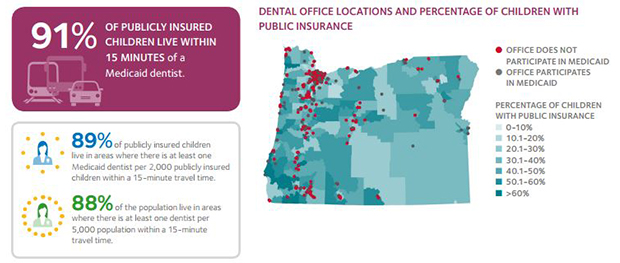Oregon Action for Dental Health
Health Policy Institute Research
A new study shows that Oregon has enough dentists now and into the future to address the state’s oral health care needs.

While the factors preventing people from getting to the dentist are varied and complex, everyone needs good dental health.
To help meet that need, Oregon Dental Association is committed to improving access across the state to ensure that every Oregonian has access to a high-quality, licensed provider regardless of their race, income or where they live.
Oregon Action for Dental Health is a community-driven initiative that aims to:
- Provide access to oral health care for every Oregonian
- Strengthen the public-private safety net for those who otherwise couldn’t afford essential care
- Expand access to education and disease prevention for underserved communities
Oregon Action for Dental Health isn’t a quick-fix, Band Aid solution. It is a long-term commitment to improve the state’s dental health. While there is no silver bullet to remove barriers to care, Oregon’s dentists are dedicated to making a difference in their communities, ensuring all Oregonians have access to high-quality dental care.
Identifying the gaps that exist for dental care in underserved communities
Providing solutions for rural Oregon
While there are enough providers now and projected in the future to serve Oregon’s needs, we must continue efforts to ensure they’re accessible to all who need them. ODA is urging the 2017 Legislature to protect and expand programs that help, including rural practitioner tax credits, loan forgiveness provided through Scholars for a Healthy Oregon, and the Oregon Medicaid Primary Care Loan Repayment and Forgiveness programs.
Innovative efforts such as Oregon Health and Science University’s virtual dental homes, which use telehealth technology to link dental hygienists in community settings to dentists in offices elsewhere, have also improved rural access to care.
Improving access to dental care for all Oregonians
Through Community Dental Health Coordinators (CDHCs), ODA is looking to bring additional dental health education and disease prevention to underserved communities. CDHCs are similar to community health workers, helping to connect people to public health resources and dentists who can provide their needed treatment. Clackamas Community College is considering a CDHC training program with American Dental Association’s approved curriculum that could help underserved populations overcome language, cultural and anxiety barriers, navigate coverage options and find the care they need.
Dentists are working with physicians and others to co-locate dental care providers with primary medical care clinics, reducing barriers while also decreasing the number of people going to emergency rooms for dental care.
Oregon Dental Association’s Mission of Mercy is a traveling dental clinic offer free screenings and services donated by volunteer dental health care providers. Since it began in 2010, the program has provided $5.5 million in free dental care to nearly 9,000 patients.
The Dental Foundation of Oregon’s Tooth Taxi is a state-of-the-art dental office on wheels with a full-time dentist and staff providing free dental care and education to uninsured and underserved children throughout the state. Since it began in 2008, the Tooth Taxi has served more than 18,000 children.
Dentists are also finding ways to strengthen and expand the public/private safety net by fighting for adequately funded Medicaid programs that encourage provider participation and for adult dental coverage in the program, among other strategies.

